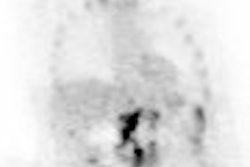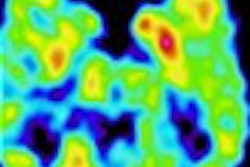A protocol for conducting fast PET/CT was the hot topic at the 2003 Society of Nuclear Medicine (SNM) meeting in New Orleans, and was selected by the society as its image of the year.
Dr. Benjamin Halpern and colleagues from the University of California, Los Angeles, delivered the results of their research on conducting a whole-body LSO PET/CT study in 7 minutes as a poster presentation at the meeting.
The group devised a weight-based PET image acquisition protocol for clinical PET/CT studies that enables whole-body scans to be conducted in 7 to 28 minutes.
According to co-author Dr. Johannes Czernin, the facility has used the weight-based PET protocol to conduct approximately 1,200 whole-body scans at about 15 minutes per scan, and has discovered 120 lesions as a result.
"While image quality can be improved by longer acquisition times, diagnostic information is not compromised with fast PET protocols," the researchers wrote. "The approach allows for considerable time savings and may decrease artifacts associated with patient motion."
Other SNM highlights
More than 4,000 physicians, scientists, pharmacists, and technologists attended this year’s SNM conference, which featured more than 1,480 scientific abstracts presenting the latest research in the field of molecular imaging. In other meeting highlights:
Pinpointing the characteristics and parameters of a fever of unknown origin (FUO) is time-consuming and potentially costly, but molecular imaging may solve the mystery, said German and Dutch investigators who turned to FDG-PET to discover the source of FUO.
Bringing a PET/CT onto a PACS network requires some unique integration gymnastics by system administrators, according to Jeffrey Leal and Dr. Richard Wahl of the Johns Hopkins Medical Institute in Baltimore.
Researchers from the University of Maryland Medical Systems in Baltimore showed that a negative FDG-PET scan is highly useful for excluding distant metastases in patients with pre-resection esophageal cancer, demonstrating accuracy for assessing distant metastatic lesions of 89% versus 71% for CT.
Although potential PET utilization has increased nearly tenfold, practice volumes haven't kept pace with the growing range of applications. Susan Minerich said that extensive educational outreach by a PET facility is also needed to increase utilization, and that it must be conducted on both a professional and community-wide level to be successful.
"Because coverage has been such a moving target for the past five years, many referrers are unaware of what is available for reimbursement. Or, if a procedure is available for reimbursement, that there are no established practice standards or guidelines for the use of PET," she said.
Epileptic patients who exhibit a resistance to anti-seizure medication may be helped by surgery. However, the success of an operation, such as anterior temporal lobectomy, depends on the localization results of PET and SPECT imaging.
"PET and ictal SPECT are the most sensitive imaging modalities for seizure localization. PET is a good predictor of surgical success," said Dr. Christopher Rowe from Austin Hospital in Melbourne, Australia, discussing the role of imaging in preoperative planning for patients with partial seizures.
Finally, in society news, Dr. Barry Siegel, director of the division of nuclear medicine, Mallinckrodt Institute of Radiology at Washington University in St. Louis, received the Georg Charles de Hevesy Nuclear Pioneer Award for his distinguished contributions to nuclear medicine. Dr. Nora Volkow, director of the National Institute on Drug Abuse at the National Institutes of Health, was the recipient of the Paul C. Aebersold Award for outstanding achievement in basic science applied to nuclear medicine.
The 2004 edition of the SNM conference will be held in Philadelphia from June 19-23, at the Pennsylvania Convention Center. Attendee pre-registration is being accepted online at the society’s Web site, http://www.snm.org/am/, until April 30, 2004.
By Jonathan Batchelor
AuntMinnie.com staff writer
September 3, 2003
Copyright © 2003 AuntMinnie.com




















